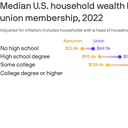There’s a wealth gap between union and nonunion workers

There's a massive wealth gap between workers in unions and nonunionized workers, across education levels, finds a new analysis from the liberal think tank Center for American Progress shared first with Axios.
Why it matters: Typically, unionized workers earn about 10%-20% more than their nonunion peers, but these wealth gaps are far wider, an indication that the benefits of union membership accrue to workers over time.
The big picture: College is still one of the best paths to accumulating wealth, this and other data show. But CAP's numbers point to an alternative for those who might not want to spend the time or money on a college education: union membership.
- Aside from higher pay, union members have more job security.
- Members are also likely to have defined benefit retirement plans, i.e. pensions, and access to better health care — so are less apt to go into debt when they're sick.
How they did it: Researchers at CAP looked at the Federal Reserve's Survey of Consumer Finances, covering 2022 data.
- They examined households where an adult age 25 or older is working and earning a wage or salary. Rich layabouts, business owners and retirees aren't included — their wealth numbers could tighten the gap.
- A union household includes a worker who is covered by a union contract. Wealth is defined as the total value of what people own — real estate, bank accounts — minus the value of their debts.
By the numbers: Overall, those in unions had a median wealth of $338,482 compared to $199,948 for nonunion workers.
- Union workers had a higher homeownership rate (71% versus 65% for nonunion), and 60% had a defined benefit pension versus 24% of the nonunion group.
Follow the money: Unionized workers with no high school diploma have more than three times the wealth of their nonunion peers.
- Those with some college under their belts — maybe an associate's degree — have two-and-half times the wealth. Folks in this group could include those in health care, like nurses or dental hygienists.
- Even college-educated union members are outpacing their peers. Workers in this category would include teachers, college professors, journalists, government employees, and many nonprofit workers. The Center for American Progress, for example, is unionized.
Reality check: The CAP report finds an association between wealth and union membership, but it doesn't look at causation — we can't know for sure what caused these higher wealth levels.
- Plus, only 10% of the workforce is in a union — we're talking about a very small group here.